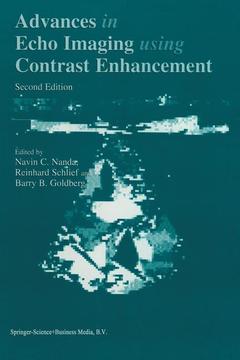Description
Advances in Echo Imaging Using Contrast Enhancement (2nd Ed., 2nd ed. 1997. Softcover reprint of the original 2nd ed. 1997)
Coordinators: Nanda N.C., Schlief Reinhard, Goldberg B.B.
Language: English
Keywords
diagnosis; echocardiography; imaging; scintigraphy; ultrasound; Ultrasonography
Publication date: 10-2012
698 p. · 16x24 cm · Paperback
698 p. · 16x24 cm · Paperback
Description
/li>Contents
/li>Comment
/li>
The first edition of this definitive text ran to 24 chapters. The second edition, reflecting the explosive growth of interest in echo-enhancement, contains 44. The first section deals with some of the most important emerging issues and technologies and covers harmonic imaging, the use of echo-enhancers to provide quantitative information, and the application of enhanced power Doppler to tissue imaging. The second, on contrast echocardiography, explores the use of echo-enhancement during transesophageal imaging. One chapter describes the use of contrast-enhancement transesophageal imaging to determine coronary flow reserve and another gives a detailed account of the application of the technique to the evaluation of left ventricular function. Other authors describe the intraoperative use of contrast echocardiography and discuss the potential of myocardial contrast echocardiography to replace thallium scintigraphy. Another chapter covers the emerging technique of transient response imaging and its role in the assessment of myocardial perfusion, and two chapters are devoted to three-dimensional contrast echocardiographic assessment of myocardial perfusion. Use of echo-enhancement in the evaluation of peripheral circulation is discussed in chapters on carotid and peripheral arterial flow imaging and others that describe renal and hepatic vascular imaging. The newer applications of echo-enhancement outside the cardiovascular system are described in three chapters devoted to the visualization of tumour vasculature. The final chapters look to the future and cover the imaging of intramyocardial vasculature, the development of site-specific agents and the emergence of the new acoustically active agents.
Part One: Echo-Enhancement Agents: Basic Aspects. 1. Contrast Echocardiography - A Historical Perspective; P.M. Shah. 2. Principles. Microbubble Fluid Dynamics of Echo Contrast; S. Meerbaum. 3. Physics of Microbubble Scattering; N. de Jong. 4. Spontaneous Echo Contrast: Etiology, Technology Dependence and Clinical Implications; A.A. Aiazian, et al. 5. Echo-Enhancing Agents: Their Physics and Pharmacology; R. Schlief. 6. Echo-Enhancing Agents: Safety; N.C. Nanda, E.L. Carstensen. 7. Behavior of Echo Contrast Microbubbles in the Microvasculature; G. Giraud, D.J. Sahn. 8. Imaging Instrumentation for Ultrasound Contrast Agents; J.E. Powers, et al. 9. Doppler Myocardial Imaging; G.R. Sutherland. 10. Quantitative Doppler Intensitometry; K.Q. Schwarz, et al. Part Two: Contrast Echocardiography: Clinical Aspects. 11. Contrast Echocardiography Today; N.C. Nanda, J.S. Raichlen. 12. Clinical Use of Contrast Agents: Technical (Practical) Considerations; J.R. Shapiro, R.S. Meltzer. 13. Right Heart Echo Enhancement in the Assessment of Pulmonary Artery Pressures and Right Ventricular Function; W.E. Kemp, Jr., B.F. Byrd, III. 14. Contrast Enhanced Color Doppler in the Assessment of Mitral Regurgitation; H. von Bibra, et al. 15. Contrast Enhanced Doppler in the Assessment of the Aortic Stenosis; S. Nakatani, K. Miyatake. 16. Detection of Intrapulmonary Vasodilatation and Diagnosis of Hepatopulmonary Syndrome Using Contrast Echocardiography; G.A. Abrams, et al. 17. Identification of Right Sided Structures by Contrast Transesophageal Echocardiography, with Emphasis on Patent Foramen Ovale; B.K. Khandheria. 18. Contrast Echo-Enhancement During Transesophageal Echocardiography: Indications and Clinical Benefits; D. Hausmann, et al. 19. Transesophageal Echocardiographic Assessment of Coronary Flow Reserve and Coronary Artery Stenosis Using Echo Enhancement; C. Caiati, et al. 20. Left Ventricular Contrast Echocardiography &endash; Echoventriculography &endash; Stress Echocardiography; R. Erbel, et al. 21. Contrast Color Flow Doppler Evaluation of the Left Ventricle; J.S. Raichlen, N.C. Nanda. 22. Usefulness of Echo-Enhancement in Stress Echocardiography (USA Experience); J. Wiewall Winkelmann, et al. 23. Assessment of Myocardial Perfusion with Various Intravenous Echo Enhancing Agents; D. Rovai, et al. 24. Myocardial Contrast Echocardiography in Ischemic Heart Disease: Osaka Experience; T. Masuyama, et al. 25. Assessment of Myocardial Viability Post-Infarction with Myocardial Contrast Echocardiography; C. Firschke, S. Kaul. 26. Can Myocardial Contrast Echo Replace Thallium? S. Beppu. 27. Intraoperative Applications of Contrast Echocardiography; J.R. Shapiro. 28. Harmonic Imaging During Contrast Echocardiography: Basic Principles and Potential Clinical Value; H.R. Villarraga, et al. 29. Transient Response Imaging During Contrast Echocardiography; T.R. Porter. 30. Three-Dimensional Echocardiographic Assessment of Myocardial Perfusion Abnormalities; J. Yao, et al. 31. Three-Dimensional Visualization of Myocardial Perfusion Using Contrast Echocardiogra
The first edition of this definitive text ran to 24 chapters. The second edition, reflecting the explosive growth of interest in echo-enhancement, contains 44. The first section deals with some of the most important emerging issues and technologies and covers harmonic imaging, the use of echo-enhancers to provide quantitative information, and the application of enhanced power Doppler to tissue imaging. The second, on contrast echocardiography, explores the use of echo-enhancement during transesophageal imaging. One chapter describes the use of contrast-enhancement transesophageal imaging to determine coronary flow reserve and another gives a detailed account of the application of the technique to the evaluation of left ventricular function. Other authors describe the intraoperative use of
© 2024 LAVOISIER S.A.S.




